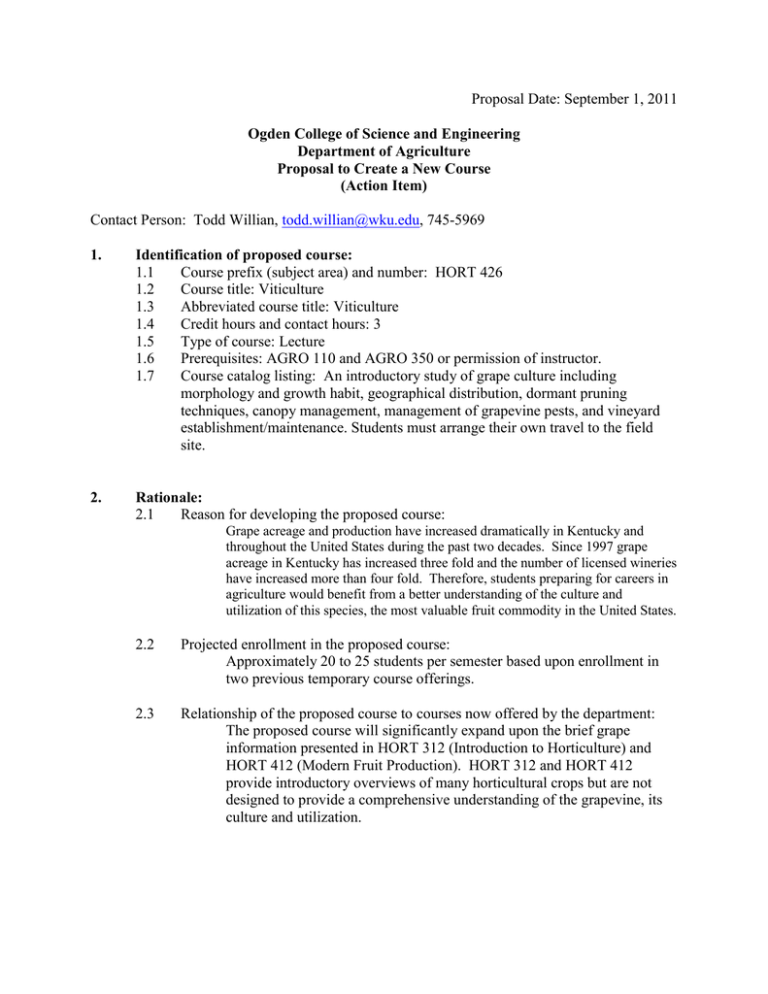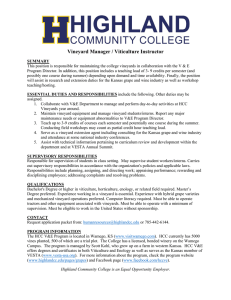HORT 426 Revision
advertisement

Proposal Date: September 1, 2011 Ogden College of Science and Engineering Department of Agriculture Proposal to Create a New Course (Action Item) Contact Person: Todd Willian, todd.willian@wku.edu, 745-5969 1. Identification of proposed course: 1.1 Course prefix (subject area) and number: HORT 426 1.2 Course title: Viticulture 1.3 Abbreviated course title: Viticulture 1.4 Credit hours and contact hours: 3 1.5 Type of course: Lecture 1.6 Prerequisites: AGRO 110 and AGRO 350 or permission of instructor. 1.7 Course catalog listing: An introductory study of grape culture including morphology and growth habit, geographical distribution, dormant pruning techniques, canopy management, management of grapevine pests, and vineyard establishment/maintenance. Students must arrange their own travel to the field site. 2. Rationale: 2.1 Reason for developing the proposed course: Grape acreage and production have increased dramatically in Kentucky and throughout the United States during the past two decades. Since 1997 grape acreage in Kentucky has increased three fold and the number of licensed wineries have increased more than four fold. Therefore, students preparing for careers in agriculture would benefit from a better understanding of the culture and utilization of this species, the most valuable fruit commodity in the United States. 2.2 Projected enrollment in the proposed course: Approximately 20 to 25 students per semester based upon enrollment in two previous temporary course offerings. 2.3 Relationship of the proposed course to courses now offered by the department: The proposed course will significantly expand upon the brief grape information presented in HORT 312 (Introduction to Horticulture) and HORT 412 (Modern Fruit Production). HORT 312 and HORT 412 provide introductory overviews of many horticultural crops but are not designed to provide a comprehensive understanding of the grapevine, its culture and utilization. 2.4 Relationship of the proposed course to courses offered in other departments: BIOL 222/223 (Plant Biology and Diversity/Lab) provides an overview of anatomy and physiology of higher and lower plants. GEOG 278 (Geography of Food and Agriculture) examines the relationships between crop distribution and cultural preference for those crops. The above courses focus upon a broad array of crop and non-crop species but do not provide a comprehensive examination of any particular crop species. The Departments of History and Geology/Geography offer HIST 341 (A Cultural History of Alcohol) and GEOG 475 (Geography of Wine), respectively. Both courses complement rather than duplicate HORT 426 topics. Although wine is the primary outlet (end product) of grape production, HORT 426 does not discuss the fermentation process and is limited in its coverage of global and domestic wine growing appellations. 2.5 3. Relationship of the proposed course to courses offered in other institutions: Many institutions offer similar courses although currently no Kentucky post-secondary institution offers a comparable course. Comparable courses include: HORT 59000 – Commercial Grape and Wine Production, Purdue University; VWT 130 – General Viticulture, Napa Valley College; and AGP 711 – Viticulture, Missouri State University. Although they do not offer Viticulture courses, the University of Kentucky Cooperative Extension Service contains Extension Viticulturists and an Extension Enologist. These personnel provide technical support and educational materials to current and future grape producers in the form of extension publications and workshops. Discussion of proposed course: 3.1 Upon completion of this course students will have gained: Historical overview of global and domestic grape production and consumption Working knowledge of grapevine anatomy and morphology Understanding of vineyard establishment and maintenance techniques with an emphasis upon canopy management Understanding of the influence of site selection, soil properties and climatic conditions upon grapevine growth and fruit yield/quality Knowledge of grapevine pests, and techniques for their management 3.2 Content outline: The Grape Plant (Anatomy & Morphology) Grape Origin, History and Uses Cultivars and Clones Vegetative Growth and Development Reproductive Growth and Development Vineyard Establishment and Maintenance Seasonal Vineyard Management Mineral Nutrition of Grapevines Grapevine Pests and Pest Management 3.3 Student expectations and requirements: Assigned readings, examinations and quizzes, and hands-on canopy management training in the WKU vineyards. Individual and/or group presentations may be assigned. 3.4 Tentative texts and course materials: Creasy, G.L. and L.L. Creasy. (2009). Grapes: Crop Production Science in Horticulture 16. CABI Press, Cambridge, MA. 295 p. Bordelon, B., et al. (2005). Midwest Grape Production Guide. The Ohio State University Extension, Bulletin 919. 155 p. 4. Resources: 4.1 Library resources: See attached Library Resource Form and Bibliography 4.2 Computer resources: Adequate 5. Budget implications: 5.1 Proposed method of staffing: Current faculty. 5.2 Special equipment needed: None 5.3 Expendable materials needed: None 5.4 Laboratory materials needed: WKU vineyards located on the WKU Agriculture Research and Education Complex. 6. Proposed term for implementation: Spring 2012 7. Dates of prior committee approvals: Agriculture Department: September 22, 2011 OCSE Curriculum Committee October 13, 2011 Undergraduate Curriculum Committee ___________________ University Senate ___________________ Attachment: Bibliography, Library Resources Form, Course Inventory Form

